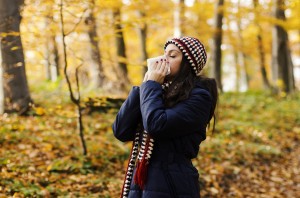Fall Allergy Season Has Arrived
With the hottest days of summer behind us and the cooler days of autumn ahead, many people look forward to the change of seasons. However, for those who suffer with allergies, this seasonal change can bring with it unwelcome symptoms such as sneezing, wheezing, coughing, runny or stuffy nose, scratchy throat, and itchy eyes. Some allergy triggers can lead to more serious asthma attacks. What culprits cause allergy sufferers to feel miserable in the fall, and what can people do to lesson those impacts?
 Most people with fall allergies are particularly sensitive to ragweed. Pollen counts don’t wait until mid-September to shoot upwards. Ragweed and grass pollen actually begin to rise in mid-August. Allergy medications should ideally be started about two weeks before any symptoms become bothersome. People with sensitivities to pollen should avoid being outdoors on windy days and limit gardening activities that expose them to pollen. Keeping windows closed helps keep pollen out of the house. Using a vacuum with a HEPA filter can remove pollen and dust mites that have settled in carpeting or on upholstered furniture. A HEPA filter on your heating system will also remove particles from the air inside your home.
Most people with fall allergies are particularly sensitive to ragweed. Pollen counts don’t wait until mid-September to shoot upwards. Ragweed and grass pollen actually begin to rise in mid-August. Allergy medications should ideally be started about two weeks before any symptoms become bothersome. People with sensitivities to pollen should avoid being outdoors on windy days and limit gardening activities that expose them to pollen. Keeping windows closed helps keep pollen out of the house. Using a vacuum with a HEPA filter can remove pollen and dust mites that have settled in carpeting or on upholstered furniture. A HEPA filter on your heating system will also remove particles from the air inside your home.
Mold spores are another fall allergy trigger. Spores can be released on days with high humidity and then blown around on windy days. Raking leaves in the fall can stir up mold spores, spreading them through the air. Allergy sufferers may need to leave this outdoor chore to others.
There are many over-the-counter allergy medications available including decongestants, antihistamines, nasal sprays, and cough suppressants. Other medications are available by prescription from your doctor, as well as allergy shots. Use caution when self-medicating and read labels carefully, as not all allergy medicines are appropriate for adults with high blood pressure or children. Talk to your doctor about which treatment plan is best for your allergy symptoms.




